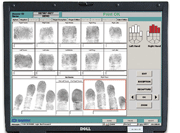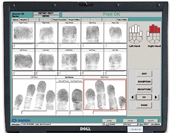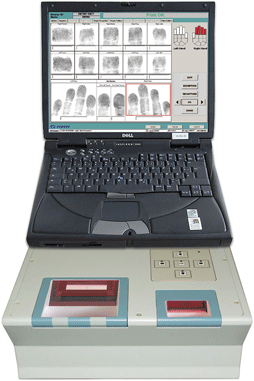31 March, 2005
category: Biometrics, Government, Library
Millions of television viewers watch each week as detectives pull latent fingerprints from crime scenes and catch bad guys with the help of a massive fingerprint database. Avid viewers even know it by name … AFIS, the Automated Fingerprint Identification System. Though it doesn’t work exactly as it appears on TV, AFIS technology is very real and it has impacts beyond law enforcement. In fact, one of the leading developers of the technology, SAGEM Morpho, believes AFIS will be key to secure deployments of large-scale ID systems such as biometric-enabled passports and government credentials.
How does an AFIS work?
Imagine the millions and millions of fingerprints taken by law enforcement agencies. They are physical prints taken on paper cards as well as electronic prints scanned on kiosks or other machines. But how do these prints make it into a system that can quickly and accurately search tens of millions of records? Lets examine the AFIS process.
1. Storing images and templates
A collected fingerprint image is compressed using a standard called WSQ compression and sent to an AFIS operator. The image is decompressed and a biometric template is created from the fingerprint image. The template is a numeric representation of the fingerprint—much like a signature of the fingerprint, containing the information that makes the fingerprint unique. The template is stored in the AFIS along with the actual fingerprint image.
2. Querying the AFIS
When an unknown fingerprint is collected at a crime scene, the first step is to create a biometric template of the image. This template is then used to search the AFIS to filter out all non-matching records and isolate a small number of potential matches.
3. Visual comparison by trained professionals
The subset of potential matches created by the AFIS is provided to a trained fingerprint expert for evaluation. The actual images are compared (rather than the numeric templates) to determine a match.
Michel LeRoy, VP Marketing and Sales Support for SAGEM Morpho, summarizes it this way: “an AFIS is just a big filter that searches a massive database of templates and provides a very short potential matching list (complete with referenced images).”
AFIS technology for law enforcement
Because of the influence of television, many people assume that there is one massive AFIS holding all fingerprint records. The reality is that many individual local, state, and national law enforcement bodies manage their own AFIS. Some have interconnections while others do not. Because most criminal activity remains localized, smaller AFIS’ continue to be viable even though television tends to portray the national or international searches.
Perhaps the most publicized system is that managed by the U.S. Federal Bureau of Investigation (FBI). In that late 1990s, Lockheed Martin and SAGEM Morpho built the system that now holds more than 40 million records and manages 70,000 queries each day. According to Teresa Wu, Marketing Specialist for SAGEM Morpho, the FBI IAFIS remains the largest law enforcement AFIS in the world.
AFIS technology expands beyond law enforcement
The mission of an AFIS – to filter a massive database of biometric templates and return a subset of potential matches with images – has implications for other areas of identification and authentication. As the use of biometrics expands into new areas of society, the AFIS need not be confined to law enforcement alone.
According to Mr. LeRoy, “based on building the IAFIS for the FBI, we saw the market for civil applications. In 1998, we deployed the very first large civil AFIS system in world.”
The system was designed to secure the Malaysian government’s multipurpose ID card. It includes 20 million records and manages 12,000 searches per day. Says Mr. LeRoy, “(Malaysia) decided to use the AFIS to make sure no one was getting two cards.” When a new enrollee requests a card, the fingerprint is checked against existing records in the AFIS for matching records.
“We found that the requirements were very different for civil systems than they were for law enforcement systems,” adds Mr. LeRoy. “Civil (staff) has no experience with fingerprints, so we had to make the systems more intuitive, more user friendly. Plus you are dealing with a larger portion of the population, not just criminals.”
Different goals require different search techniques
In law enforcement systems, the typical search involves taking a single template and searching the entire database of templates for likely matches. This type of search is referred to as a one-to-many search. It is the key to identifying the individual record.
In civil systems, there is a need for another type of search. Rather than identifying an unknown individual there is often the need to determine whether or not an individual is who they claim to be. The need is to authenticate the individual’s identity. Rather than a one-to-many search, authentication relies on a one-to-one comparison.
In many environments, both techniques are utilized. For example, imagine that an AFIS has been employed for the purpose of securing a new electronic passport system. When an individual visits a passport office to request a new document, his fingerprint will be scanned, the template created, and checked against the database of passport holders to ensure that he has not already received a document using a different identity. This is a one-to-many search.
Later, when he returns to the U.S. after traveling abroad, his actual fingerprint will templated and checked against the template stored in the passport. If they match, his identity is authenticated and he can enter the country. Additionally, a passport document itself could be authenticated via a one-to-one comparison of the template it holds with the one held in the AFIS. This could be guard against document tampering.
The future of AFIS technology
It is clear that the largest area for the expansion of AFIS technology is into markets other than law enforcement. Law enforcement is a mature market for the technology, and says Ms. Wu, “the majority of the large multi-million dollar systems are already in place.”
She notes, however, that SAGEM Morpho is now focusing on smaller more cost effective systems for local and regional law enforcement agencies. “Now we can propose a 100,000 record AFIS (that operates) on a single PC for just tens of thousands of dollars.”
“We feel confident that civil applications,” she stresses, “will grow larger than law enforcement.” Passport and travel document systems, national ID systems, voter registrations, driver licenses, government and military credentials, and a host of other systems are likely to adopt biometric technologies for increased security.


 Millions of television viewers watch each week as detectives pull latent fingerprints from crime scenes and catch bad guys with the help of a massive fingerprint database. Avid viewers even know it by name …
Millions of television viewers watch each week as detectives pull latent fingerprints from crime scenes and catch bad guys with the help of a massive fingerprint database. Avid viewers even know it by name …  AFIS technology for law enforcement
AFIS technology for law enforcement The system was designed to secure the Malaysian government’s multipurpose ID card. It includes 20 million records and manages 12,000 searches per day. Says Mr. LeRoy, “(Malaysia) decided to use the AFIS to make sure no one was getting two cards.” When a new enrollee requests a card, the fingerprint is checked against existing records in the AFIS for matching records.
The system was designed to secure the Malaysian government’s multipurpose ID card. It includes 20 million records and manages 12,000 searches per day. Says Mr. LeRoy, “(Malaysia) decided to use the AFIS to make sure no one was getting two cards.” When a new enrollee requests a card, the fingerprint is checked against existing records in the AFIS for matching records.
